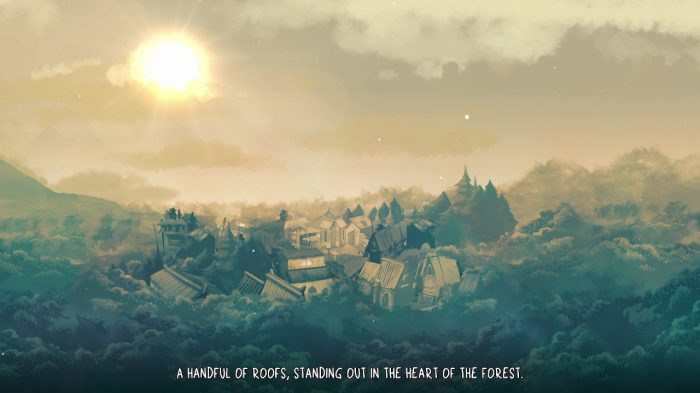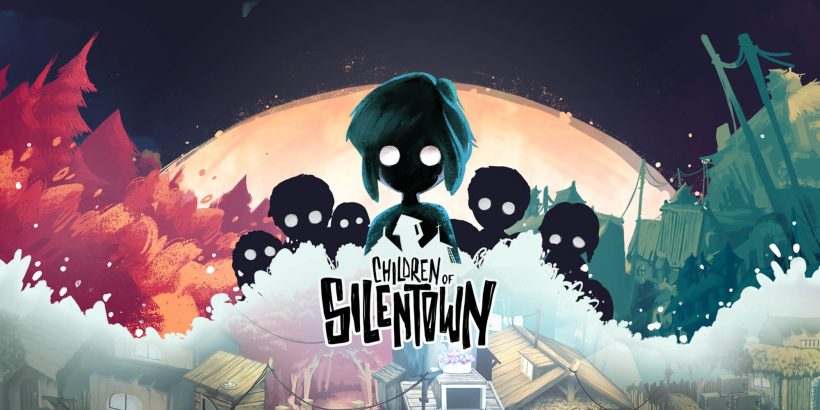If you go down to the woods today… well, don’t. Just don’t.
For the woods contain monsters and the monsters take people. So fares the premise of Children of Silentown, an unsettling, hand-drawn point-n-click from Elf Games. You’ll play as Lucy, a curious child with much to be curious about. Why are people disappearing? Where exactly do they go? And who will be next?

Silentown is a tiny village, nestled in the middle of a forest, inhabited by a cast of inquisitive children and weary adults who tell tales of those monsters that lurk in the trees. Forever urging caution, silence, and quiet obedience, they go about their everyday lives simply striving to survive. But Lucy seeks more: an explanation of recurring nightmares and an understanding of her parents’ murky history.
While the game has plenty of tricks up its sleeve, it’s first and foremost a point-and-click adventure, presented in a hand-drawn style with a veneer of darkness. There’s a gothic edge to the illustrations; characters are mostly pale, with wide blank stares and there’s clearly a Tim Burton influence underlying everything. This style suits both the general narrative here, and the genre itself, honing in on the confusion and sense of disorientation that can really drive a puzzle adventure forward.

As an adventure, Children of Silentown does its best to borrow from recent advances introduced by similar games: interactive objects highlight automatically, and there are no complicated verb sets to choose from, everything just works together or doesn’t. There’s a mechanism by which you can combine items in your inventory, and this contributes to widening the options available to you. Some objects change their nature as you progress through the story, which means you can’t rest on your laurels, having dismissed something the first time around.
The game has two innovations of note: its puzzle minigames and the songs that unlock them. You’ll gain access to these songs by collecting notes from various situations, and you can deploy them on characters, items, and locations alike. In effect, these tunes act as permanent inhabitants of your inventory, ready to be used time and time again. There’s a sense in which this contributes to some trial-and-error, however, and you’ll need to collect these songs in a linear fashion anyway, so the feature can feel a bit underused by the time the story concludes.
The bigger problem, however, the classic problem that every single point-and-click is destined to suffer, is that trial and error temptation that looms over the gameplay, much as the monsters loom over this population. There’s forever a conflict between riddles that are far too trivial and those which head too far into obscurity. Some seem obtuse, simply for the sake of it: a lock that cannot be opened by any of the keys you might acquire must be opened with brute force instead.

Fortunately, the game has some saving graces. For a start, there’s the plot which, while far from original, paints a sympathetic narrative with plenty of interesting dialogue. Cut scenes make the most of the rough yet colourful style to keep you thoroughly entertained — if you’re willing to sit back and be a spectator for long stretches.
In addition, the minigames that arise after you unleash a song are a nice break from the standard point-and-click fare, although they too are susceptible to trial-and-error guessing games. In fact, more than once I accidentally solved one of these puzzles—especially those of a certain type—and was left unsatisfied, robbed of a challenge just as I was beginning to get a grip on it. But they’re definitely a fun distraction and are woven into the gameplay with just about the right frequency.
Tying all this together is perhaps the game’s greatest win: its use of dynamic locations. Return to Monkey Island recently did a great job in this regard, revisiting locations time and time again, adding twists, and reinventing settings as its story progressed. Children of Silentown attempts a similar feat and pulls it off with great success, doing an even better job in my opinion. Its map is relatively small, but it never feels overly limited because there are so many variations with every twist in the tale.

Aside from the puzzle issues, there are some minor problems. One or two locations are difficult to find, given the game’s inconsistent labelling; some exits are clearly signposted and ‘actionable’, others aren’t. The minigames are reasonably well explained, but there’s definitely room for improvement. On one occasion, I swear I had an acceptable solution which the game did not accept, for whatever reason. The identification of the closest interactive object doesn’t always feel spot on.
But, small flaws side, if you can gel with the core point-n-click mechanic, Children of Silentown is a more-than-decent offering. If you’ve never played an adventure game like this before, it might not totally sell you on the genre, but fans will find plenty to enjoy here.
Children of Silentown £17.99
Summary
Children of Silentown will be a polarising game, mainly because of the point-and-click nature. But with a compelling storyline, attractive visuals, and excellent reuse of location, adventurers who don’t mind a bit of trial and error are well served here.

